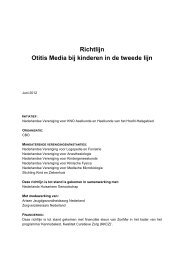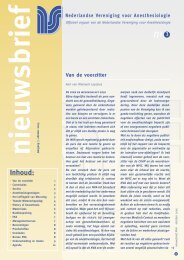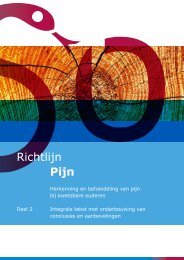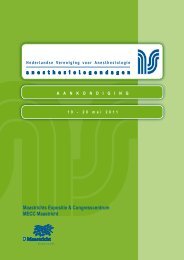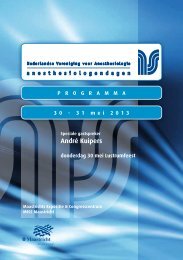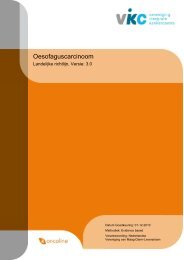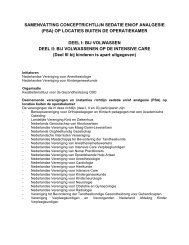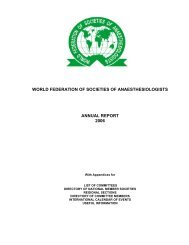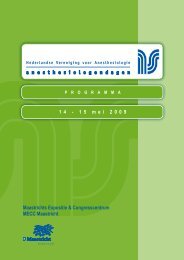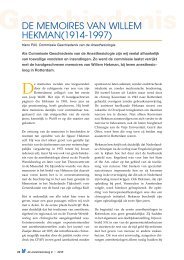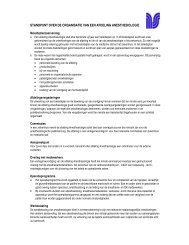Knelpunten in het management van acute pijn bij kinderen
Knelpunten in het management van acute pijn bij kinderen
Knelpunten in het management van acute pijn bij kinderen
Create successful ePaper yourself
Turn your PDF publications into a flip-book with our unique Google optimized e-Paper software.
mei '10 nederlands tijdschrift voor anesthesiologie 17<br />
|<br />
1. Neonatal pa<strong>in</strong> exposure and<br />
its long-term consequences<br />
Newborns are often exposed to noxious<br />
stimuli <strong>in</strong> the neonatal <strong>in</strong>tensive<br />
care unit (NICU). The impact of this<br />
pa<strong>in</strong> exposure is <strong>in</strong>creas<strong>in</strong>g due to high<br />
preterm birth rates and medical ad<strong>van</strong>ces<br />
which decrease the gestational<br />
age at which preterm born neonates<br />
survive. Besides major surgery, neonates<br />
undergo many noxious stimuli<br />
for monitor<strong>in</strong>g of their health status <strong>in</strong><br />
the NICU for which analgesia is often<br />
<strong>in</strong>adequately adm<strong>in</strong>istered. In a Dutch<br />
NICU, neonates received up to 14 daily<br />
repetitive noxious rout<strong>in</strong>e procedures,<br />
such as heel pricks, <strong>in</strong>jections and <strong>in</strong>tubations<br />
[1].<br />
It has been suggested that neonatal<br />
pa<strong>in</strong> exposure has a long-term impact<br />
on pa<strong>in</strong> sensitivity later <strong>in</strong> life.<br />
Sensory neuronal circuits with<strong>in</strong> the<br />
CNS are still undergo<strong>in</strong>g development<br />
after birth and this development is<br />
activity-dependent, i.e. the formation<br />
and extension of the pa<strong>in</strong> network is<br />
based on the amount of nociceptive<br />
stimuli neonates receive [2]. Excessive<br />
noxious stimulation of the pa<strong>in</strong><br />
network via either major surgery or<br />
repetitive pa<strong>in</strong> exposure <strong>in</strong> the NICU<br />
may result <strong>in</strong> different pa<strong>in</strong> response<br />
later <strong>in</strong> life. For <strong>in</strong>stance, children who<br />
had experienced neonatal surgery,<br />
showed an <strong>in</strong>creased need of <strong>in</strong>tra- and<br />
post-operative analgesia follow<strong>in</strong>g<br />
surgery <strong>in</strong> the same dermatome later<br />
<strong>in</strong> life[3]. Also, neonatal circumcision<br />
<strong>in</strong>creased the pa<strong>in</strong> response to a future<br />
pa<strong>in</strong> stimulus, i.e. rout<strong>in</strong>e vacc<strong>in</strong>ation,<br />
three months later [4]. Not only<br />
neonatal surgery, but also a history of<br />
NICU-stay has been l<strong>in</strong>ked with longterm<br />
changes <strong>in</strong> pa<strong>in</strong> sensitivity. Preterm<br />
and full-term school-aged (9-11<br />
years) children previously exposed to<br />
pa<strong>in</strong>ful NICU procedures were found<br />
to be less sensitive to <strong>acute</strong> heat stimulation<br />
than children which were not<br />
exposed to NICU <strong>in</strong>terventions, which<br />
reflects a decreased basel<strong>in</strong>e pa<strong>in</strong> sensitivity<br />
[5]. In contrast, when exposed to<br />
a prolonged noxious thermal stimulus,<br />
the ex-NICU children showed lower<br />
pa<strong>in</strong> thresholds than control children<br />
[5]. In conclusion, cl<strong>in</strong>ical evidence is<br />
accumulat<strong>in</strong>g on the impact of early<br />
life pa<strong>in</strong> exposure and its long-term<br />
consequences on pa<strong>in</strong> sensitivity.<br />
2. Analgesia <strong>in</strong> newborns<br />
and <strong>in</strong>fants: An evidence<br />
based approach<br />
Pa<strong>in</strong> and anxiety have been recognized<br />
as significant problems <strong>in</strong> hospitalized<br />
children. Especially <strong>in</strong> the very young<br />
and under specific conditions (postoperative;<br />
critically ill children), there<br />
is a lack of evidence-based selection<br />
and dos<strong>in</strong>g of analgesics, while longterm<br />
consequences of prolonged use<br />
of these drugs are unknown. Eighty<br />
percent of drugs are used off-label<br />
and/or unlicensed. This has raised<br />
public awareness <strong>in</strong> both the USA<br />
and EU (Best Pharmaceuticals for<br />
Children Act <strong>in</strong> 2002, NIH/FDA meet<strong>in</strong>g<br />
2004, European law dedicated<br />
to Medic<strong>in</strong>es and Children, 2007).<br />
The European Medic<strong>in</strong>es Agency<br />
(EMEA) has identified a number of<br />
analgesics and sedatives as research<br />
focus for pa<strong>in</strong> and anxiety <strong>in</strong> l<strong>in</strong>e with<br />
the recently released Medic<strong>in</strong>es for<br />
Children Research Network (MCRN)<br />
and the ERA-NET PRIOMEDCHILD<br />
(2008). These priorities <strong>in</strong>clude<br />
morph<strong>in</strong>e and paracetamol <strong>in</strong> the<br />
newborn, peri-operative paracetamol<br />
and midazolam. The EPIPAIN study<br />
(Epidemiology of Procedural Pa<strong>in</strong> <strong>in</strong><br />
neonates) revealed that each neonate<br />
was found to experience a median of<br />
115 procedures dur<strong>in</strong>g a study period<br />
of 14 days while the majority (79,2%)<br />
of these procedures was not accompanied<br />
by analgesia [6]. It is thought<br />
that adequate analgesic therapy for<br />
neonates receiv<strong>in</strong>g <strong>in</strong>tensive care may<br />
be beneficial with respect to shortterm<br />
and perhaps long-term outcomes<br />
[7-9]. However, two studies on shortterm<br />
effects of opioids <strong>in</strong> premature<br />
neonates showed m<strong>in</strong>imal to no effects<br />
on the behavioural pa<strong>in</strong> scores and<br />
slightly reduced stress hormone levels<br />
follow<strong>in</strong>g cont<strong>in</strong>uous morph<strong>in</strong>e treatment<br />
<strong>in</strong> ventilated newborns [10, 11].<br />
None of the studies provided enough<br />
evidence to recommend cont<strong>in</strong>uous<br />
morph<strong>in</strong>e as a standard of care for<br />
preterm ventilated newborns. A recent<br />
Cochrane review [12] came to the same<br />
conclusion. Nowadays paracetamol is<br />
the most common used analgesic and<br />
antipyretic drug <strong>in</strong> children and even<br />
prescribed <strong>in</strong> neonates to treat mild<br />
to moderate pa<strong>in</strong> or comb<strong>in</strong>ed with<br />
opioids. Paracetamol is less potent<br />
than opioids and with probably less<br />
side effects, although hepatotoxicity is<br />
described [13-16]. Limited studies are<br />
published on the use of <strong>in</strong>travenous<br />
paracetamol <strong>in</strong> preterm neonates,<br />
especially those under the gestational<br />
age of 28 weeks. To provide evidence<br />
for the most effective and safe drug<br />
for newborns and <strong>in</strong>fants, studies are<br />
needed on the effects and safety of<br />
paracetamol and morph<strong>in</strong>e <strong>in</strong> young<br />
<strong>in</strong>fants. As evidence for morph<strong>in</strong>e <strong>in</strong><br />
neonates is subject to debate, studies<br />
on (opioid sav<strong>in</strong>g properties of )<br />
paracetamol are needed. In particular,<br />
<strong>in</strong> post-operative conditions and after<br />
prolonged use <strong>in</strong> critically ill children.<br />
With<strong>in</strong> these studies, emphasis should<br />
be put upon the characterization<br />
of the optimal dose based on body<br />
weight, post-menstrual and post-natal<br />
age. Therefore the <strong>in</strong>fluence of age<br />
on the pharmacok<strong>in</strong>etic (PK) and<br />
pharmacodynamic (PD) parameters<br />
of these drugs should be <strong>in</strong>vestigated.<br />
Ad<strong>van</strong>ced statistical techniques such<br />
as non-l<strong>in</strong>ear mixed effects modell<strong>in</strong>g<br />
are applied. Us<strong>in</strong>g these modell<strong>in</strong>g<br />
techniques, <strong>in</strong>frequently obta<strong>in</strong>ed<br />
samples and observations <strong>in</strong> the real<br />
life cl<strong>in</strong>ical situation can be utilized to<br />
analyze population PK (drug concentrations)<br />
and PD (efficacy and safety<br />
endpo<strong>in</strong>ts) as well as determ<strong>in</strong>ants<br />
of variability <strong>in</strong> drug response. Ultimately<br />
this results <strong>in</strong> rational <strong>in</strong>dividualized<br />
dos<strong>in</strong>g regimens for neonates<br />
and <strong>in</strong>fants.<br />
3. The development of<br />
experimental neonatal<br />
pa<strong>in</strong> animal models<br />
Three important research questions<br />
arise from the abovementioned cl<strong>in</strong>ical<br />
evidence for long-term changes<br />
<strong>in</strong> pa<strong>in</strong> sensitivity after early-life pa<strong>in</strong><br />
exposure <strong>in</strong> the NICU and use of analgesia<br />
<strong>in</strong> neonates and <strong>in</strong>fants:<br />
1. What are the underly<strong>in</strong>g mechanisms<br />
of long-term consequences of<br />
repetitive neonatal pa<strong>in</strong> exposure?<br />
2. Which analgesic drugs are effective<br />
for pa<strong>in</strong> <strong>management</strong> <strong>in</strong> neonates<br />
and <strong>in</strong>fants and can they affect the<br />
long-term pa<strong>in</strong> sensitivity changes?<br />
3. PK and PD parameter characteristics<br />
of analgesic drugs <strong>in</strong> neonates<br />
and <strong>in</strong>fants?<br />
Due to several important limitations<br />
<strong>in</strong> cl<strong>in</strong>ical research, experimental<br />
neonatal pa<strong>in</strong> models have been developed.<br />
To study the underly<strong>in</strong>g mechanisms<br />
of the long-term changes <strong>in</strong> pa<strong>in</strong><br />
sensitivity follow<strong>in</strong>g neonatal pa<strong>in</strong>



